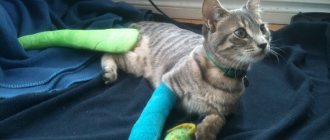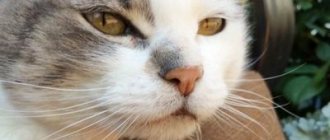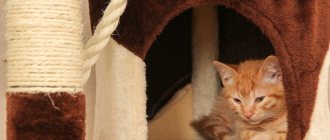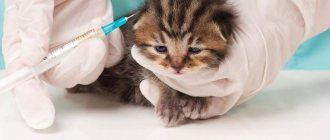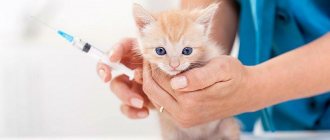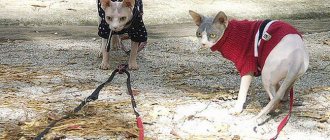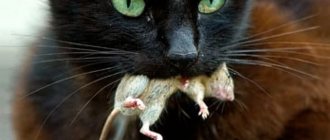Physiological change of teeth
Kittens are born toothless. Their primary incisors erupt at the age of 1-2 weeks. A two-month-old baby should already have at least 26 teeth. But they begin to fall out at 3-4 months. The change process also lasts 3-4 months, ending at 7 months.
Monitor your baby's health, count how many and which teeth have fallen out. An adult cat should have 30 of them: 6 incisors, 2 canines, 2 molars on the lower and upper jaws. There are 10 premolars: 6 on the lower jaw and 4 on the upper jaw.
When changing baby teeth, a cat may experience symptoms such as:
- hypersalivation;
- chewing inedible objects;
- decreased activity;
- irritability, excitability.
Often the process of changing teeth occurs with complications - instead of 4 fangs, 8 grow. This is due to the fact that the formation of molars occurs in separate follicles: the milk ones have not yet fallen out, but new ones are already actively growing. The kitten experiences discomfort, cannot chew and therefore loses weight.
In such cases, you need to go to the clinic to have a specialist remove the loose tooth. The procedure is performed under anesthesia.
Change of teeth, which takes place without complications, does not require medical intervention. The main thing is that the dishes in the baby’s diet contain the required amount of mineral salts, calcium and phosphorus.
How to help your pet
An attentive owner manages to notice problems in time and take action. But if it’s not entirely clear why a cat’s teeth fall out before the age of 6, try to independently determine the direction of the search:
- With age-related tooth loss, they fall out in a strict order: first the incisors, then the canines, then the premolars and molars. The loss is extended over time. If this order is broken, then you need to look for another reason.
- If you find wounds on the gums or chipped enamel, take measures to neutralize the consequences of the injury.
- Pay attention to the presence of tartar and caries, a specific (sweet, putrid, sour) odor from the mouth. If the gums have changed color, the crowns wobble or look transparent, gray, or black, this is a direct indication of disease. If you notice these signs, contact your veterinarian for treatment.
Something else interesting: How many teeth do cats have?
Causes of tooth loss in adult cats
It is easy to distinguish baby teeth from permanent ones: the first ones are white, sharp, like needles. They are slightly flat, and there is a slight thinning where the tooth meets the gum. The fangs are curved back. Indigenous (permanent) have a yellowish tint, with a more rounded cross-section. The canines are straight, there is no thinning in the gum area.
If a cat is kept in good conditions, receives a balanced diet enriched with nutrients, vitamins and microelements, and is not exposed to external traumatic factors, it may well retain its teeth into old age.
However, if a pet loses them after it is 1 year old, that is, we are talking about the loss of permanent teeth, this is an alarming signal, indicating the presence of serious pathologies occurring in the body.
It is important to understand: adult cats’ teeth do not simply fall out. This is a problem not only of the oral cavity, but also of the whole body, since the mucous membrane of the mouth and gums have many blood vessels through which the infection spreads throughout the body.
By the age of three, a cat’s dental plaque turns into stone, so the oral cavity needs careful care - cleansing with special pastes. If hygiene procedures are neglected, tooth loss cannot be avoided in the future.
Tooth loss in an adult animal may indicate the following problems in the body:
- injuries in the mouth;
- weakening of the immune system;
- disruption of the natural microflora in the oral cavity, colonization of it by pathogenic bacteria;
- vitamin deficiency;
- diabetes mellitus;
- tartar;
- metabolic disorders;
- changes in hormonal levels (pregnancy, taking hormonal medications, including contraceptives, antibiotic therapy, etc.);
- dental diseases (gingivitis, periodontal disease, caries, etc.);
- malocclusion;
- gastrointestinal pathologies;
- oncology.
The idea that all cats lose their incisors in old age is wrong. If the animal is healthy, the onset of old age is not an argument for poor dental health. The exception is the age of 20 years and older, but a rare cat survives to that age.
The loss of the chewing apparatus of its structural units is associated with diseases, poor care and unbalanced nutrition, but not with age.
Over the years, various changes in the condition and shape of teeth still occur. It has been proven that the approximate age of a cat can be determined by the number of worn teeth - the more teeth there are, the older the animal.
The first to wear off are the incisors on the lower jaw (towards the edges from the center), their shape becomes transversely oval. Then comes the turn of the molars and premolars. The last ones to lose enamel are the fangs.
Feeding a cat without teeth
If for some reason your cat is left without teeth, do not despair. In nature, the cat family needs teeth to bite or strangle prey. With their fangs they tear off smaller pieces from large pieces of meat and swallow.
At home, a toothless cat can be provided with soft food. To do this, purchase canned meat and fish purees and pates at the pet store. Soak dry food with water no higher than 30 degrees. Please note: not broth, not milk - but water!
Cats' gums are very sensitive to cold and hot food, so food should be at room temperature. If the cat eats natural food (we don’t really recommend this, and we certainly warn against combining “natural” food with professional food), then it is better to refuse beef and replace it with white chicken or rabbit meat (pork and fish are completely harmful for cats). An older cat should eat more often than usual (three to four times a day), but the portions will be smaller, although the total volume remains the same.
The age of a person can be easily determined by the number of wrinkles and flabby muscles, but the age of cats is revealed by their teeth. In older cats they are worn out and more yellow. But by taking preventive measures and caring for your furry pet with love, you will help keep his teeth for as long as possible.
Main symptoms
The clinical picture of tooth loss varies depending on the cause that caused this phenomenon. If a structural unit of the chewing apparatus falls out due to injury, it is enough to treat the wound with a disinfectant solution, and if it does not become infected, the damaged area will heal safely.
The following symptoms are reasons to contact a veterinary clinic:
- gums swell, redden, bleed;
- saliva is released abundantly, which is why the cat’s face and neck are constantly wet;
- ulcers form in the oral cavity;
- pus in saliva;
- a foul smell of rotting emanates from the mouth;
- presence of difficulties with chewing;
- lack of appetite.
As a rule, the cat’s behavior changes, he becomes restless, apathetic, and loses weight. The animal refuses food, even if it is very hungry. If a cat tries to eat, he does it very carefully and slowly, as chewing causes him discomfort. As a rule, he also refuses water.
The owner should observe the condition of the animal; it is advisable to write down changes in order to tell the veterinarian about them. This will greatly facilitate diagnosis and determine treatment.
Edentia of the upper jaw
The upper jaw is more often than the lower jaw and is subject to various types of anomalies. As a rule, patients have symmetrical hypodentia of two teeth. And since the front teeth are involved in sound production and form the purity of pronunciation, this type of deformation is the most noticeable. The patient's speech becomes lisping and slurred, the smile “creeps away”, and saliva splashes.
Edentia of the lower jaw
The lower jaw has a small prosthetic bed, so when edentulous, the tongue begins to take the place of the lower teeth. As a result, the patient’s diction changes significantly and his well-being worsens.
Treatment method and prognosis
There is no single treatment regimen. Therapy is compiled individually in each specific case and depends on the age of the cat, its state of health and the cause of tooth loss. A lost tooth cannot be restored; the veterinarian’s task is to prevent subsequent losses.
To solve the problem, the specialist makes adjustments to the cat’s diet and prescribes medications to strengthen the teeth and immune system.
Regarding vitamin therapy, we can say that there is no need to give vitamin C in loading doses. In cats, ascorbic acid is synthesized in sufficient quantities, so they do not develop scurvy.
If the animal has tartar, it is removed in the clinic. The procedure is performed under anesthesia, for which premedication is used - the administration of anticholinergic drugs to block vagal reflexes. These drugs cause the least harm to the animal’s body. During the operation, the cat will be conscious, but will not be able to resist.
After recovering from anesthesia, your pet will need quality care, as the procedure is stressful for him.
In parallel with this, treatment is carried out aimed at strengthening the gums and reducing their bleeding. But the main emphasis is on eliminating the underlying disease that caused tooth loss.
Caring for an older cat's teeth
According to statistics, 70% of cats over 12 years old lose teeth. However, as we have already said, this depends much more on the characteristics of care, and not on age. And the statistics are explained by the fact that not all owners, unfortunately, take responsibility for the health of their pets, especially if they are elderly (but for a cat, the age of 14-15 years can be considered as such).
Read more about the age of cats: How old is a cat by human standards?
You should take care of your older cat's teeth in the usual way - brushing with toothpaste or gel two to three times a week. To do this, place your pet on your lap with his back to you, press his head with one hand and lift his lip with your index finger.
You can clean with a toothbrush or a finger brush. Movements are performed on the upper teeth - from top to bottom, and on the bottom row - from bottom to top. Toothpaste for cats does not foam and does not require rinsing.
After the procedure, pet your pet and treat her to something tasty, thus encouraging and calming her.
A cat's enamel is worn out as it ages, so you need to be more attentive to the condition of its oral cavity. Visit a veterinarian - if necessary, he will prescribe treatment or remove the diseased tooth.
What to do at home
The owner is required to strictly follow the veterinarian's instructions. Self-medication is dangerous for the cat’s health and can cause irreparable harm to it. Medicines and their dosage are determined by a specialist.
In order for the animal to lead a normal lifestyle, it is necessary to change the consistency of the food, since dry hard granules can further injure the oral cavity.
The oral cavity is regularly examined and treated with a disinfectant solution of Chlorhexidine. These procedures prevent infection of the enamel and damage to other teeth.
Why can the periosteum of a tooth become inflamed?
The most common is odontogenic periostitis of the jaws, that is, an inflammatory process provoked by diseases of the teeth or periodontal tissues. Deep caries, pulpitis, periodontitis (inflammatory process at the apex of the tooth root), periodontitis - all these diseases, if not treated in time, lead to the appearance of gumboil. Also, one of the reasons for the development of the inflammatory process may be alveolitis - inflammation of the tooth socket, which in some cases occurs after tooth extraction. Inflammation of the periosteum after tooth extraction usually develops in those patients who do not rush to see a dentist when the first signs of complications appear in the postoperative period.
Much less common is toxic periostitis, caused by infection through the blood or lymph (usually due to some general infectious disease). The disease can also be caused by injuries to the jaw bone or surrounding soft tissue.
What if the roots are not affected by caries?
In dental practice, decisions about the need for root removal have to be made quite often. So, if a “living” healthy tooth splits due to injury, its roots are usually slightly damaged and can be saved. But the roots of a pulpless and treated tooth are, as a rule, removed so that they can be replaced with a titanium implant and a crown made of metal ceramics or zirconium dioxide can be installed on it. As a rule, destroyed rear molars, the most problematic in the dentition, are also removed along with the roots.
Quite often, even if there is a therapeutic option to preserve the root, real professionals still refuse it. They know from experience in which cases the crown will not be attached securely enough to the restored native root, and therefore will not be fully functional. Therefore, it is best to entrust the decision on the advisability of preserving roots to a highly qualified specialist.
Table: how to figure out who to contact
| What's troubling? | Which dentist should I contact? |
| Bleeding gums/Teeth sensitivity | Hygienist or periodontist |
| Missing teeth | Orthopedist |
| Have crooked teeth/bad bite | Orthodontist |
| Tooth hurts / The wall has broken off / There is caries | Therapist |
| The wisdom tooth is painfully erupting / Swelling has appeared on the side of the cheek | Surgeon |
All dentists conduct an examination, consultation, draw up a treatment plan and perform a thorough diagnosis of the entire oral cavity. In modern dentistry, an integrated approach to each clinical situation is valued, taking into account all the individual characteristics of the patient’s body.
Pediatric dentist
Treatment and extraction of teeth for patients under 18 years of age is carried out by a pediatric dentist. When working with young patients, the primary task is to find contact with the child and get him ready for treatment, because almost all children enter any medical office with fear. In addition, the children's doctor needs to tell the child's parents how to carry out home oral hygiene for the baby, what products to use, when the physiological change of teeth occurs, etc.
Maintaining dental health from a very early age is necessary for the normal formation of the dental system.
How to treat inflammation of the periosteum of a tooth before visiting a doctor?
Self-medication for any purulent processes is very dangerous, so it is recommended to consult a dentist at the first symptoms of the disease. However, before visiting a doctor, the patient can alleviate his condition somewhat by applying cold to the cheek on the affected side and rinsing his mouth with an antiseptic solution at room temperature (chlorhexidine soda-saline solution, chamomile or sage decoctions). Here's what you absolutely can't do:
- Apply warm compresses and drink hot drinks.
- Apply any bandages yourself or use medications without a doctor’s prescription.
- It is better not to take analgesics before visiting the dentist.
- If you are undergoing surgery (opening an abscess), you should not take aspirin, since it changes the rheological properties of the blood and can cause bleeding.
Dental roots affected by caries are a dangerous source of infection in the body.
When the carious process has destroyed not only the crown, but also the roots of the tooth, it is necessary to part with them as quickly as possible. Removing the root of a decayed tooth cannot be called a simple surgical procedure, but modern anesthetics and professional skills allow the doctor to carry it out quickly and without significant pain. If this is not done, rotting roots will create a serious health problem for the patient.
- Pathogenic microflora will spread to neighboring teeth.
- There will be a persistent unpleasant odor from the mouth.
- A cyst or granuloma may form around the root tip. Pus from the overgrown local formation will sooner or later release into the gum tissue - a flux will form, which will already capture the entire upper or lower jaw and “swell” the cheek.
- A persistent focus of infection will cause a significant decrease in immunity.
When treating gumboil, the patient's gums are first cut under anesthesia to allow the drainage of pus and to disinfect the source of infection. Without this manipulation, it is impossible to remove the tooth root, since it is impossible to inject an anesthetic into the gum tissue filled with pus. When sending a patient home, the dentist cannot even be sure that he will return to remove the root. Unfortunately, many avoid surgical intervention, which means they will soon face a relapse of the disease.
Possible complications and diagnosis
If the disease is not treated properly, very serious complications soon develop: osteomyelitis (purulent inflammation of bone tissue, provoking its necrosis), phlegmon (a diffuse purulent process that affects nearby tissues and requires immediate surgical intervention), sepsis (a general infection of the body, often ending in the death of the patient ). Each of these conditions requires emergency medical care and long, painstaking treatment. Therefore, it is better not to let the situation lead to complications and contact a dentist at the first signs of an inflammatory process.
To establish an accurate diagnosis, the doctor will need to conduct a differential diagnosis using instrumental diagnostic methods (radiography, CT). This disease is similar in symptoms to acute periodontitis, acute inflammation of the salivary glands, lymphadenitis, and osteomyelitis. Therefore, in order to prescribe adequate treatment, it will be necessary to exclude these conditions and accurately determine the cause of the patient’s poor health.
